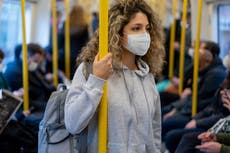The Independent's journalism is supported by our readers. When you purchase through links on our site, we may earn commission.
What we know about the Covid variant BA.2.86 dubbed as ‘Pirola’
The new Covid strain was placed under the World Health Organisation’s monitoring list
A new Covid variant dubbed “Pirola” is sweeping the United States and is currently being closely monitored by the World Health Organisation.
“Pirola” is a combination of the Greek letters Pi and Rho, has more than 30 mutations to its spike protein compared to XBB.1.5, a variant of Omicron that had been the dominant strain in the US, according to a Thursday bulletin in Yale Medicine.
“Such a high number of mutations is notable,” said Yale Medicine infectious diseases specialist Scott Roberts, MD.
Dr Roberts said that this was similar to the number of mutations that differed between Delta, one of the early strains of the coronavirus, and Omicron.
“When Omicron hit in the winter of 2021, there was a huge rise in COVID-19 cases because it was so different from the Delta variant, and it evaded immunity from both natural infection and vaccination,” Dr Roberts added.
“The other concern is that this strain has been picked up in at least six countries, and the cases are unrelated. This suggests some degree of transmission in the [international] community that we’re not detecting.”
What is BA.2.86?
Maria Van Kerkhove, an epidemiologist and lead for the Covid response at the WHO, said very limited information was available on the newly discovered strain. But a large number of mutations within it needed closer monitoring, she wrote on Twitter.
“Surveillance, sequencing and Covid-19 reporting [are] critical to track known and detect new variants,” she added.
The variant, also referred to as BA.X, was found through genetic sequencing – a process where scientists determine the building blocks of a molecule’s DNA.
Scientists are on alert due to the overly high number of mutations of the variant, with more than 30 in the spike protein – the part of the virus that vaccines aim to neutralise.
How many cases are there in the US?
Pirola has been found in 10 states, according to data from GISAID, a global database.
So far, it has been found in Colorado, Maryland, Michigan, New York, Ohio, Oregon, Pennsylvania, Texas, Virginia, and Washington.
The CDC noted in a statement released 23 August that the current hospitalisations in the country are not “likely” driven by BA.2.86, but added, “this assessment may change as additional data become available.”
Globally, the variant has been detected in Denmark, Sweden, South Africa, Israel, Canada, the United Kingdom and the US, as The Independent previously reported.
Covid hospitalisations and deaths have steadily risen for the last several weeks, as the US sees the effect of a summer surge.
From 3 September to 9 September, hospitalisations from the virus rose 7.7 per cent compared to the previous week, the most recent data from the Centers for Disease Control and Prevention (CDC) show.
During that same time, deaths rose 4.5 per cent.
As the summer surge has gained traction, experts have started speaking more about preventative measures. In a recent interview with CNN, Dr Anthony Fauci said he hopes Americans wear masks to protect their loved ones if case counts continue to rise.
What can you do to protect yourself?
The CDC has advised people to protect themselves from the virus as it is not yet clear “how well this variant spreads,” however as a precautionary measure people have been asked to do the following:
• Get your Covid-19 vaccines.
• Get tested for Covid.
• Seek treatment if you have Covid-19 and are at high risk of getting very sick
• If you choose to wear a mask, wear a high-quality one that fits well over your nose and mouth Improve ventilation.
•Wash your hands.
What are the symptoms?
Symptoms of the new variant include a runny nose, headache, fatigue, sneezing and a sore throat.
What are the experts saying?
Kristian G Andersen, an immunologist and infectious diseases expert, said the lineage had all the hallmarks of something that could take off, but added: “Our immunity landscape is now complex, so it’s too early to say it will.”
Dr S. Wesley Long, medical director of diagnostic microbiology at Houston Methodist, a flagship Texan hospital, said it remained to be seen whether BA.2.86 would be able to out-compete other strains of the virus or have any advantage in escaping immune responses from prior infection or vaccination.
Researchers are currently studying how much — if any — protection against BA.2.86 might be offered from immunity from previous Covid infections, per The New York Times. However, the research on this topic is still in its infancy, so it’s difficult to say for sure how past infections may influence Pirola cases.
Join our commenting forum
Join thought-provoking conversations, follow other Independent readers and see their replies
Comments




Bookmark popover
Removed from bookmarks